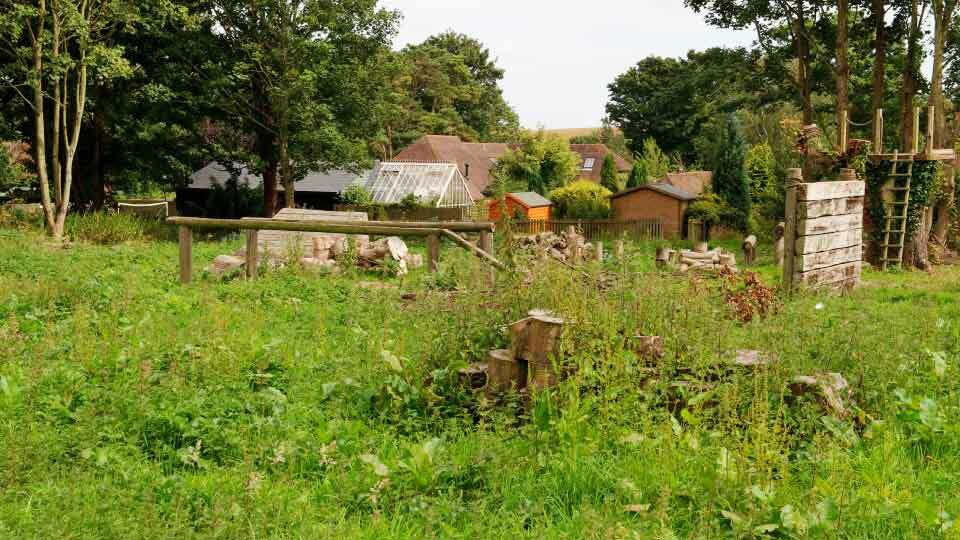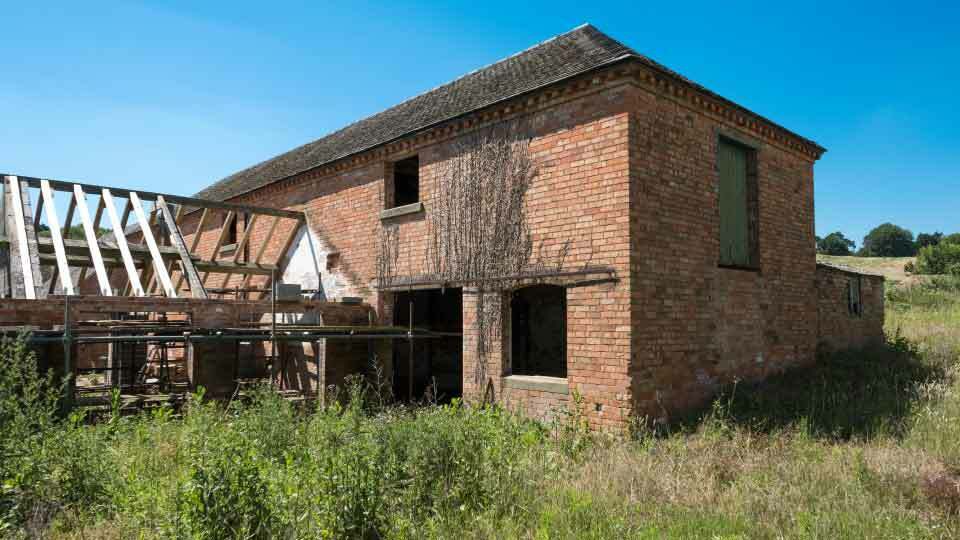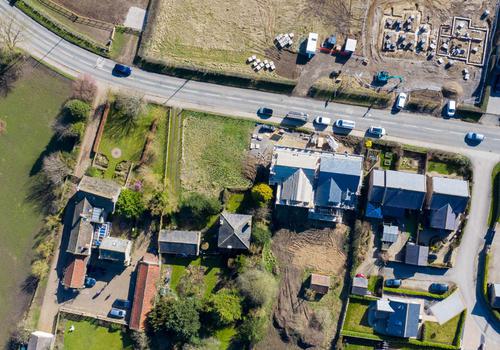Finding a plot is one of the first major tasks on your self-build checklist. Without land to build on, your dream home will stay a dream. That being said, it can be tricky to know where to begin and what questions to ask once you do. We’ve gathered our best advice to get you started.
Firstly, make sure you register with your local authorities ‘Right to Build’ register. Local planning authorities have a legal obligation to monitor the demand for plots. They will need to consider the plots available to self-builders on their register, so they can satisfy demand in the planning permission process.
For the nitty gritty business of actually finding a plot, it’s important not to limit yourself to one method. Head online and make full use of the plot finding websites. Keep an eye on auctions and get out and about in the area where you want to build to see what’s there. Make sure that everyone you know is aware that you’re looking, as multiple pairs of eyes are better than one.
Top tips for finding a self build plot
Be clear on what you need. Before you start your search for the perfect plot, you need to understand what perfect means for you. Asking yourself these fundamental questions will help:
- Which area do you want to live in?
- What's your total budget and how much of this will you need to spend on land?
- How much garden would you want from the plot?
- Are you looking to build a bungalow, two-storey house or 7-bedroom manor?
All these things will influence how and where to start looking.
Traditional approaches to finding a plot
- Land & Property Auctions are often good places to find plots or dilapidated houses.
- Infill plots or disused land may look narrow and uninviting. But can provide surprising opportunities for building your dream home. Especially in towns or cities. Every site is unique and the designs can be tailored to make the home truly yours.
- Speak to professionals. Surveyors, architects and builders will all be 'in the know'.
- Visit estate agents and land agents in your area and register your interest with them.
Remember, do not purchase a plot without planning permission as you may not be able to build on it. You do not want to be left with an expensive field. Make sure you take advice from your solicitor prior to buying any property or piece of land.
Innovative ways to find a plot of land
It's important to be creative when plot-hunting. Though traditional approaches, such as plot search websites, can yield results. We encourage people to follow advice from our Self Build Academy and to look at more innovative methods, to finding a plot of land.
- Narrow your search
Many people assume that the broader the area the more luck they'll have finding a plot. In fact, having a radius too wide may mean you miss plots and can't see the wood for the trees. Whilst it is sensible to have a few areas in mind, you should prioritise them. Zone in on particular towns or villages and start your search from there.
- Take a walk or a drive
Spend time looking in and around towns or villages you'd like to live in. Identify infill plots, where a piece of land sits unused between two existing houses. Don't discount houses built on corner plots. These may have a large plot with the potential for development. The owner could be interested in selling off a part of their garden.
- Plots with an existing house on
Have you considered buying a plot which already has a house or bungalow on it? Demolishing a house and replacing it with a new one known as a ‘Replacement Dwelling’ is a very popular strategy. In fact, almost half of today’s self-builders choose this route. Not only does this open up many more opportunities for plots. It also means that you are likely to gain planning consent if a dwelling is already present on the site. There could also be the possibility of increasing the footprint or height. However, this will vary depending on local policy, so it’s worth bearing this in mind.
- Send letters out
You can usually find local flyer distribution companies who will drop letters on your behalf. Draft a simple letter stating that you're looking for a plot to self build. This is a proven successful marketing tactic for estate agents. Used when they need to find properties in a particular area. So it may well pay off for you too.
- Place an advert in a magazine
Place an advert in a newspaper or village magazine. Try putting a small notice up in local shops or pubs. Local people know the area and they are likely to spread the word. If someone has a large garden or plot for sale, you may well be the first person they call.
- Approach the local council
Sites with overgrown gardens or even run-down properties could be potential self-build sites. Councils must bring a derelict site back into use or offer it for sale. If a site has sat dormant for a while and is council owned, then this could offer an opportunity!
- Pay a finders fee
Consider paying a finders fee to the one person who brings you the plot you eventually build on. Work out what you want to pay, make it worthwhile, and remember you’ll only be paying it once.
- Register for Potton Custom Build Plots
We are always bringing new plots to market which have planning permission for Potton homes. These sites are available across the UK. Simply register your interest with Potton Custom Build and you will be the first to know when new sites are added. We’re also not the only active business in this market, so keep an eye out to what others are doing as well.
The settlement boundary rule
The golden rule is that if a plot is outside the settlement boundary, you are unlikely to get planning permission, unless there is already a dwelling on it. Maps within the local plan documentation can show you exactly where this boundary is, you can find them on your local council website. Sometimes you might find a plot next to a boundary with a road and pavement back to the settlement. In this case it could be worth an enquiry, especially if the local council needs to build more homes.
You could also check the status of the council’s five-year land supply, which might go in your favour. Just bear in mind that a plot half a mile away from the settlement down a beaten track is probably a no go.
A picturesque square of countryside just outside a settlement would make the perfect plot, right? Unfortunately, if it looks like a field, it’s probably a field!
Anything with horses, sheep, or cattle is a definite no, because that land is already in use. And again, an area or field outside the settlement boundary is probably just that, a field. While you might think it’s not being used, it might be arable land used seasonally for farming. As appealing as an expanse of green might seem, steer clear of these kinds of 'plots'. Often, they're not really building plots at all.
And to add to the conundrum, lots of green spaces are now protected as Green Belt land, meaning they will remain undeveloped. Councils are very reluctant to approve new builds in countryside. As they want to preserve this land from development.
Top four types of building plots
There are a lot of misconceptions about what kind of land is suitable for building a house on. We want to debunk some of the myths and arm you with the knowledge you need to identify a plot when you come across it.
When people think about self-build plots, they tend to picture rolling fields in countryside settings. You might be surprised to know that this is rarely true. In fact, almost all of those fields will never get planning permission.
But don't despair! There are a lot of other easier ways to find plots that are far more likely to get planning consent:
Infill plots
Infill plots are strips of land sandwiched between two existing houses. They’re usually in a developed area, with services and road access nearby. As long as they’re not part of a green corridor or an area reserved to preserve animal habitats. Then this could be an excellent choice.

Garden plots
Like infilling, a garden plot involves taking a portion of a property’s garden and using it for development. Just like with infill plots, mains and water services are easily available.
Road access can sometimes be tricky though. If there’s no road to the rear of the existing property, you will have to build one alongside it to reach the new garden plot. There is also the problem of overlooking. Make sure that the garden is big enough to accommodate a new house. Allowing adequate room between it and neighbouring properties. And, of course, you'll have to find a sizeable garden. It will need to be large enough to accommodate a home and leave enough original garden space behind.
You also need to make sure you won’t cause a loss of amenity to the neighbours. Again, looking at maps will give you a clue to whether a garden plot will gain approval from the local authority. Some councils look upon them more favourably than others., so if you can see evidence of them nearby, that’s a great sign. Particularly if the type of development is described as back land or tandem development as many authorities are not keen on this form of development.

Brownfield land
As unappealing as it might look at first, brownfield land is an excellent option. It’s the term for land that has been previously developed. This previous development means that services and road access are already in place. And planning permission is likely to be granted, because the site was home to a building before. You should still investigate the site thoroughly, as some restrictions could apply. Such as maintaining the old building’s footprint. One point to remember when looking at brownfield land, agricultural buildings do not fall under brownfield sites.
Replacement dwellings
Fast becoming the most popular route to self-building! Constructing a replacement dwelling involves locating a plot with an existing house. It can often be one that’s dilapidated or otherwise unattractive. If the price for renovation is higher than the cost to demolish and rebuild. Then a replacement dwelling is the way forward. Like brownfield sites, they are very likely to gain planning permission. With services already linked. Some councils can also allow a larger footprint for the replacement dwelling. Which means you can get a bigger house than the original.

Read more about Planning Permission for Demolishing and Replacing an Existing Building.
After you’ve identified a possible plot
Once you've asked yourself all the important questions when identifying a possible plot, it’s time to start considering other factors:
Planning permission
You should always make sure there is planning permission in place before you buy a plot. So you can be certain you’ll be able to build on it. Be careful to check that the permission is current. If it has lapsed or is about to lapse, it could mean serious complications for you. Always check with planning professionals before buying a plot. Making sure that what you want to do is actually possible. If you don't own the land you can use an option agreement to secure your right to purchase the plot. This will allow you to purchase the land if it gets planning approval.
Covenants
Check if there are any legal conditions governing the land and what can be built there. You don’t want to buy a plot and suddenly discover that you can’t do anything with it as it has restrictive covenants that you failed to find out about.
Type of title
You need to be sure that the title deeds you’d be getting are ‘absolute’ rather than ‘possessory’. A possessory title means that ownership of the property could potentially be disputed. There are ways to manage the risk like Possessory Title Indemnity Insurance. But do you want the complication of buying a plot like this?
Access
Does the plot have access to a highway? Does the access belong to the property or is it shared with neighbours? The highway should ideally have ‘adopted’ status. Meaning that a local authority has taken responsibility for its upkeep. You also need to beware of deceptive things like so called ‘ransom strips’. These are tiny portions of land owned by third parties that block access to the property from the public highway. It is always sensible to get legal advice to check the reality of the access situation. Even if everything looks fine!
Mains services
You’ll need to know whether services, such as electricity, water, gas and telecoms, are already in place. If they aren’t, then you will need to work out which you need. You can then calculate the cost of installing them, and then work out if you have the budget for it.
Soil surveys for self build
Undertaking a soil survey early on could save you from expensive disasters.
Before buying a plot, a soil survey will help you assess the type of foundation needed to build a house. It should provide detailed information on the characteristics of the ground and quality of earth. It can also highlight any anomalies in the ground conditions. Which you may need to consider before progressing to groundworks stage.
We’ve found that one of the biggest grey areas for many self-builders is budgeting for foundations. Which is why we usually advise a ground investigation that includes a soil survey. From the results of this survey, a foundation can be engineer designed to your site. Moreover, most warranty providers will insist on an engineer designed foundation.
Is a soil survey necessary?
To budget for foundations for a self build it is important to avoid any potential surprises. Investing in a soil survey is normally money well spent and will help to avoid the unforeseen later on.
If there are problems with the plot, these may come to light when a survey is conducted. Issues such as poor soil composition or drainage would add costs to your budget and build. You should be aware of these before you buy.
Ideally this sort of information should be made available to you by the person selling the plot. However this is not always the case. So, unless you want to allow for more budget in your contingency, you should get a survey done as soon as possible. It may just save you a lot of money in the long run.
How is the soil survey undertaken?
A soil survey should be carried out by a suitably qualified consultant or company. Typically, both the top soil and subsoil are investigated. This determines soil material, pH levels, particle size and potential contamination.
Trial holes are dug and photos and notes of soil type are recorded. Soil samples are then taken and sent to a laboratory for analysis. Holes (which can be up to 3m deep) are then filled in following the survey.
How much does a soil survey cost?
The digging of trial pits, soil testing and percolation tests can normally be completed for around £1,500 - £2,000.




